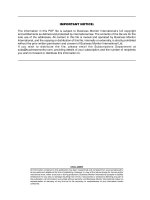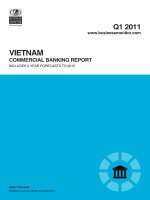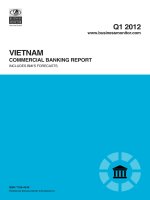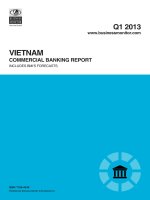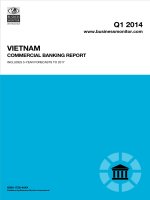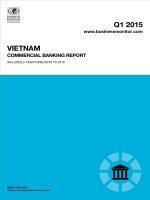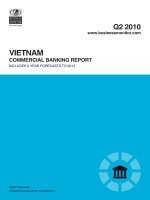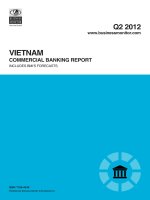Vietnam commercial banking report q2 2013
Bạn đang xem bản rút gọn của tài liệu. Xem và tải ngay bản đầy đủ của tài liệu tại đây (455.39 KB, 79 trang )
Q2 2013
www.businessmonitor.com
VIETNAM
COMMERCIAL BANKING REPORT
INCLUDES 5-YEAR FORECASTS TO 2017
ISSN 1758-454X
Published by:Business Monitor International
Vietnam Commercial Banking
Report Q2 2013
INCLUDES 5-YEAR FORECASTS TO 2017
Part of BMI’s Industry Report & Forecasts Series
Published by: Business Monitor International
Copy deadline: February 2013
Business Monitor International
Senator House
85 Queen Victoria Street
London
EC4V 4AB
United Kingdom
Tel: +44 (0) 20 7248 0468
Fax: +44 (0) 20 7248 0467
Email:
Web:
© 2013 Business Monitor International
All rights reserved.
All information contained in this publication is
copyrighted in the name of Business Monitor
International, and as such no part of this
publication may be reproduced, repackaged,
redistributed, resold in whole or in any part, or used
in any form or by any means graphic, electronic or
mechanical, including photocopying, recording,
taping, or by information storage or retrieval, or by
any other means, without the express written consent
of the publisher.
DISCLAIMER
All information contained in this publication has been researched and compiled from sources believed to be accurate and reliable at the time of
publishing. However, in view of the natural scope for human and/or mechanical error, either at source or during production, Business Monitor
International accepts no liability whatsoever for any loss or damage resulting from errors, inaccuracies or omissions affecting any part of the
publication. All information is provided without warranty, and Business Monitor International makes no representation of warranty of any kind as
to the accuracy or completeness of any information hereto contained.
CONTENTS
BMI Industry View 7
Table: Levels (VNDbn) 7
Table: Levels (US$bn) 7
Table: Levels At May 2012 7
Table: Annual Growth Rate Projections 2012-2017 (%) 8
Table: Ranking Out Of 62 Countries Reviewed In 2013 8
Table: Projected Levels (VNDbn) 8
Table: Projected Levels (US$bn) 8
SWOT 9
Commercial Banking 9
Business Environment 10
Economic 11
Political 12
Industry Forecast 13
Speeding Up Banking Reforms 14
Foreign Investors Could Remain Cautious 15
Industry Risk Reward Ratings 16
Asia Commercial Banking Risk/Reward Ratings 16
Table: Asia Commercial Banking Business Environment Ratings 17
Market Overview 18
Asia Commercial Banking Overview 18
Table: Banks' Bond Portfolios 2011 18
Table: Asia Commercial Banking Business Environment Ratings 19
Table: Comparison of Loan/Deposit & Loan/Asset & Loan/GDP ratios, 2013 20
Table: Anticipated Developments in 2014 21
Table: Comparison of Total Assets & Client Loans & Client Deposits (US$bn) 22
Table: Comparison of US$ Per Capita Deposits (2013) 23
Table: Interbank Rates and Bond Yields 24
Economic Outlook 25
Ratings Downgrade Failed To Surprise Investors 26
Early Signs Of A Recovery 28
Threat Of Slower Growth Yet To Undermine Efforts For Reforms 28
Expenditure Breakdown 28
Table: Vietnam - Economic Activity 29
Competitive Landscape 30
Market Structure 30
Protagonists 30
Table: Protagonists In Vietnam's Commercial Banking Sector 30
Vietnam Commercial Banking Report Q2 2013
© Business Monitor International Page 4
Definition Of The Commercial Banking Universe 30
List Of Banks 31
Table: Financial Institutions In Vietnam 31
Company Profile 34
Bank for Foreign Trade of Vietnam (Vietcombank) 34
Table: Stock Market Indicator 36
Table: Balance Sheet (VNDmn) 36
Table: Balance Sheet (US$mn) 36
Table: Key Ratios (%) 37
VietinBank 38
Table: Stock Market Indicators 40
Table: Balance Sheet (VNDmn) 40
Table: Balance Sheet (US$mn) 40
Table: Key Ratios (%) 41
Agribank 42
Table: Balance Sheet (VNDmn) 43
Table: Balance Sheet (US$mn) 44
Table: Key Ratios (%) 44
Asia Commercial Bank 45
Table: Stock Market Indicators 46
Table: Balance Sheet (VNDmn) 47
Table: Balance Sheet (US$mn) 47
Table: Key Ratios (%) 47
Eximbank 48
Table: Stock Market Indicators 50
Table: Balance Sheet (VNDmn) 50
Table: Balance Sheet (US$mn) 50
Table: Key Ratios (%) 51
Vietnam Technological and Commercial Joint-stock Bank (Techcombank) 52
Table: Balance Sheet (VNDmn) 53
Table: Balance Sheet (US$mn) 53
Table: Key Ratios (%) 54
Viet A Joint Stock Commercial Bank (Vietabank) 55
Housing Development Commercial Joint Stock Bank (HDBank) 57
Sacombank 59
Table: Stock Market Indicators 61
Table: Balance Sheet (VNDmn) 61
Table: Balance Sheet (US$mn) 61
Table: Key Ratios (%) 62
Regional Overview 63
Asia Overview 63
Investment Banking Revenues Surge 64
Malaysia Takes The Lead 65
Thai Commercial Banks Targeting High-Growth Economies 66
Global Industry Overview 67
Vietnam Commercial Banking Report Q2 2013
© Business Monitor International Page 5
Global Commercial Banking Overview 67
Table: Selected Highlights Of Changes To The Formulation of the Basel III Liquid Coverage Ratio 69
Demographic Forecast 71
Table: Vietnam's Population By Age Group, 1990-2020 ('000) 72
Table: Vietnam's Population By Age Group, 1990-2020 (% of total) 73
Table: Vietnam's Key Population Ratios, 1990-2020 74
Table: Vietnam's Rural And Urban Population, 1990-2020 74
Methodology 75
Commercial Bank Business Environment Rating 76
Table: Commercial Banking Business Environment Indicators And Rationale 77
Weighting 78
Table: Weighting Of Indicators 78
Vietnam Commercial Banking Report Q2 2013
© Business Monitor International Page 6
BMI Industry View
Table: Levels (VNDbn)
Date
Total
assets
Client
loans
Bond
portfolio Other
Liabilities
and
capital Capital
Client
deposits Other
May 2011 3,117,942 2,630,220 223,644 264,078 3,117,942 494,104 2,241,245 382,593
May 2012 3,545,801 2,835,610 355,354 354,837 3,545,801 569,584 2,668,471 307,746
Change, % 13.7% 7.8% 58.9% 34.4% 13.7% 15.3% 19.1% -19.6%
Source: BMI; Central banks; Regulators
Table: Levels (US$bn)
Date
Total
assets
Client
loans
Bond
portfolio Other
Liabilities
and
capital Capital
Client
deposits Other
May 2011 151.76 128.02 10.89 12.85 151.76 24.05 109.09 18.62
May 2012 169.90 135.87 17.03 17.00 169.90 27.29 127.86 14.75
Change, % 12.0% 6.1% 56.4% 32.3% 12.0% 13.5% 17.2% -20.8%
Source: BMI; Central banks; Regulators
Table: Levels At May 2012
Loan/deposit ratio
Loan/asset ratio Loan/GDP ratio GDP Per Capita, US$ Deposits per capita, US$
106.26% 79.97% n.a. 1,072.13 1,433.70
Falling Falling Falling n.a. n.a.
Source: BMI; Central banks; Regulators
Vietnam Commercial Banking Report Q2 2013
© Business Monitor International Page 7
Table: Annual Growth Rate Projections 2012-2017 (%)
Assets Loans Deposits
Annual Growth Rate 11 9 6
CAGR 13 11 8
Ranking 15 22 35
Source: BMI; Central banks; Regulators
Table: Ranking Out Of 62 Countries Reviewed In 2013
Loan/deposit ratio
Loan/asset ratio Loan/GDP ratio
11 2 14
Local currency asset growth Local currency loan growth Local currency deposit growth
14 16 22
Source: BMI; Central banks; Regulators
Table: Projected Levels (VNDbn)
2009 2010 2011 2012e 2013f 2014f 2015f 2016f 2017f
Total assets 2,286,321 2,953,153 3,437,893 3,816,061 4,350,310 4,959,353 5,604,069 6,276,557 6,966,979
Client loans 1,869,260 2,475,540 2,829,890 3,084,580 3,454,730 3,869,297 4,294,920 4,724,412 5,149,609
Client deposits 1,680,717 2,209,896 2,483,357 2,706,859 2,977,545 3,245,524 3,505,166 3,750,528 3,975,560
e/f = estimate/forecast. Source: BMI; Central banks; Regulators
Table: Projected Levels (US$bn)
2009 2010 2011 2012e 2013f 2014f 2015f 2016f 2017f
Total assets 123.73 151.46 163.44 181.41 209.15 241.16 275.66 312.27 348.35
Client loans 101.16 126.96 134.54 146.64 166.09 188.15 211.26 235.05 257.48
Client deposits 90.95 113.34 118.06 128.68 143.15 157.82 172.41 186.59 198.78
e/f = estimate/forecast. Source: BMI; Central banks; Regulators
Vietnam Commercial Banking Report Q2 2013
© Business Monitor International Page 8
SWOT
Commercial Banking
Vietnam Commercial Banking SWOT
Strengths
■
Untapped potential.
■
High savings rate of the Vietnamese people.
■
Increasingly open to foreign banks since WTO accession in 2007.
■
The role of state-owned banks is decreasing.
Weaknesses
■
Domestic banks lack capital and technology to sustain high credit and efficient
growth.
■
The financial accounts of many banks are still opaque.
■
Small banks have a high exposure to real estate and stock market loans.
Opportunities
■
The population is still underbanked.
■
Income levels likely to rise strongly over the medium term.
Threats
■
Macroeconomic instabilities threaten the credibility of the government and could
potentially drive economic policy away from further liberalisation.
■
The high level of government debt could crowd out the private sector and potentially
trigger a fiscal crisis.
Vietnam Commercial Banking Report Q2 2013
© Business Monitor International Page 9
Business Environment
SWOT Analysis
Strengths
■
Vietnam has a large, skilled and low-cost workforce, which has made the country
attractive to foreign investors.
■
Vietnam's location - its proximity to China and South East Asia, and its good sea links
- makes it a good base for foreign companies to export to the rest of Asia and
beyond.
Weaknesses
■
Vietnam's infrastructure is still weak. Roads, railways and ports are inadequate to
cope with the country's economic growth and links with the outside world.
■
Vietnam remains one of the world's most corrupt countries. According to
Transparency International's 2012 Corruption Perceptions Index, Vietnam ranks 123rd
out of 176 countries.
Opportunities
■
Vietnam is increasingly attracting investment from key Asian economies, such as
Japan, South Korea and Taiwan. This offers the possibility of the transfer of high-tech
skills and know-how.
■
Vietnam is pressing ahead with the privatisation of state-owned enterprises and the
liberalisation of the banking sector. This is likely to offer foreign investors new entry
points.
Threats
■
Ongoing trade disputes with the US, and the general threat of American
protectionism, which will remain a concern.
■
Labour unrest remains a lingering threat. A failure by the authorities to boost skills
levels could leave Vietnam a second-rate economy for an indefinite period.
Vietnam Commercial Banking Report Q2 2013
© Business Monitor International Page 10
Economic
SWOT Analysis
Strengths
■
Vietnam has been one of the fastest-growing economies in Asia in recent years, with
GDP growth averaging 7.1% annually between 2000 and 2011.
■
The economic boom has lifted many Vietnamese out of poverty, with the official
poverty rate in the country falling from 58% in 1993 to 14.0% in 2010.
Weaknesses
■
Vietnam still suffers from substantial trade, current account and fiscal deficits, leaving
the economy vulnerable to global economic uncertainties in 2012. The fiscal deficit is
dominated by substantial spending on social subsidies that could be difficult to
withdraw.
■
The heavily-managed and weak currency reduces incentives to improve quality of
exports, and also keeps import costs high, contributing to inflationary pressures.
Opportunities
■
WTO membership has given Vietnam access to both foreign markets and capital,
while making Vietnamese enterprises stronger through increased competition.
■
The government will in spite of the current macroeconomic woes, continue to move
forward with market reforms, including privatisation of state-owned enterprises, and
liberalising the banking sector.
■
Urbanisation will continue to be a long-term growth driver. The UN forecasts the
urban population rising from 29% of the population to more than 50% by the early
2040s.
Threats
■
Inflation and deficit concerns have caused some investors to re-assess their hitherto
upbeat view of Vietnam. If the government focuses too much on stimulating growth
and fails to root out inflationary pressure, it risks prolonging macroeconomic
instability, which could lead to a potential crisis.
■
Prolonged macroeconomic instability could prompt the authorities to put reforms on
hold as they struggle to stabilise the economy.
Vietnam Commercial Banking Report Q2 2013
© Business Monitor International Page 11
Political
SWOT Analysis
Strengths
■
The Communist Party of Vietnam remains committed to market-oriented reforms and
we do not expect major shifts in policy direction over the next five years. The one-
party system is generally conducive to short-term political stability.
■
Relations with the US have witnessed a marked improvement, and Washington sees
Hanoi as a potential geopolitical ally in South East Asia.
Weaknesses
■
Corruption among government officials poses a major threat to the legitimacy of the
ruling Communist Party.
■
There is increasing (albeit still limited) public dissatisfaction with the leadership's tight
control over political dissent.
Opportunities
■
The government recognises the threat corruption poses to its legitimacy, and has
acted to clamp down on graft among party officials.
■
Vietnam has allowed legislators to become more vocal in criticising government
policies. This is opening up opportunities for more checks and balances within the
one-party system.
Threats
■
Macroeconomic instabilities in 2012 are likely to weigh on public acceptance of the
one-party system, and street demonstrations to protest economic conditions could
develop into a full-on challenge of undemocractic rule.
■
Although strong domestic control will ensure little change to Vietnam's political scene
in the next few years, over the longer term, the one-party-state will probably be
unsustainable.
■
Relations with China have deteriorated over recent years due to Beijing's more
assertive stance over disputed islands in the South China Sea and domestic criticism
of a large Chinese investment into a bauxite mining project in the central highlands,
which could potentially cause wide-scale environmental damage.
Vietnam Commercial Banking Report Q2 2013
© Business Monitor International Page 12
Industry Forecast
BMI View: Efforts by the State Bank of Vietnam (SBV) to recapitalise ailing banks and strengthen
regulatory oversight have helped to fend off a full-blown banking crisis for now. We believe that investors
are increasingly confident of the government's ability to contain the risk of a banking crisis while Vietnam's
bullish long-term growth story remain intact.
Our long-held view that concerns over an impending collapse of Vietnam's banking system are largely
unwarranted and that the government is unlikely to require assistance from the International Monetary Fund
(IMF) to finance a bailout, is slowly being vindicated (see 'Keeping A Cautious Outlook Amid Rising NPLs',
September 17 2012). Efforts by the State Bank of Vietnam (SBV) to rapidly recapitalise ailing banks and
strengthen regulatory oversight of lending practices have helped to fend off a full-blown banking crisis for
now. Meanwhile, average lending rates have fallen from around 20% in the beginning of 2012 to around
14% at the time of writing, and we expect credit conditions to continue to improve over the coming months.
Confidence Is Returning
Vietnam - Ho Chi Minh Stock Index (VNI)
Source: BMI, Bloomberg
Vietnam Commercial Banking Report Q2 2013
© Business Monitor International Page 13
Using the benchmark Ho Chi Minh Stock Index (VNI) as a gauge for sentiment on the overall economy (see
chart), we believe that investors are increasingly confident of the government's ability to contain the risk of
a banking crisis while Vietnam's bullish long-term growth story remain intact. Fitch Ratings
also reaffirmed Vietnam's long-term foreign and local currency debt ratings at 'B+' in January, citing the
country's strong growth potential, favourable environment for attracting foreign direct investment (FDI),
and manageable external debt levels relative to the region. From our perspective, progress on banking sector
reforms will continue to play a crucial role in further bolstering investor confidence going forward. This
should in turn determine the strength of the economic recovery over the coming quarters (we forecast real
GDP growth to accelerate from 5.0% in 2012 to 7.0% in 2013).
Credit Conditions To Pick Up In 2013
Vietnam - Outstanding Credit, VNDbn (LHS) & % chg y-o-y (RHS)
Source: BMI, State Bank of Vietnam
Speeding Up Banking Reforms
We are optimistic that the government will meet its target of restructuring ailing banks by the end of 2013,
mainly through efforts to recapitalise banks with weak balance sheets and merging smaller banks that are
struggling to compete effectively. The urgent need to restructure the banking sector and reinstate confidence
has also helped to speed up progress on free-market initiatives such as allowing for greater foreign
participation and privatising other state-owned enterprises (SOEs). According to a report published by The
Vietnam Commercial Banking Report Q2 2013
© Business Monitor International Page 14
Wall Street Journal, the government may soon allow foreign investors to hold a 49% stake in state-owned
banks or even larger stakes conditional upon an agreement to divest holdings at a later stage (presently,
foreign companies are allowed to hold a maximum 20% stake as a single entity, or 30% with a partner).
A joint Financial Sector Assessment Program undertaken by the World Bank and IMF is scheduled to be
completed by the end of H113, and is expected to provide greater transparency regarding the actual level of
non-performing loans (NPLs) across the banking sector. Estimates provided by the SBV currently put NPLs
at close to 9.0% of total outstanding loans as of the end of 2012 and it is widely expected that the actual
figure could be significantly higher. In any case, we believe that the assessment program will provide a
good framework for the government to further improve transparency and accounting standards going
forward.
Foreign Investors Could Remain Cautious
We expect this process of restructuring the banking sector to keep earnings depressed for the foreseeable
future and we maintain a cautious outlook on the banking sector through 2013. We view FDI inflows into
the banking sector as a crucial element of the restructuring process and we highlight the downside risk that
foreign investors may avoid participating in large-scale privatisation of state-owned banks. Given the
uncertainties surrounding the true exposure of NPLs, we expect foreign investors to remain highly cautious
in taking up stakes in smaller state-owned banks. However, as the economic recovery gathers pace and
assuming that actual NPLs are in line with current expectations, we expect FDI inflows into the banking
sector to pick up gradually over the course of the year.
Vietnam Commercial Banking Report Q2 2013
© Business Monitor International Page 15
Industry Risk Reward Ratings
Asia Commercial Banking Risk/Reward Ratings
Business Environment Rating Methodology
Since Q108, we have described numerically the banking business environment for each of the countries
surveyed by BMI. We do this through our Commercial Banking Business Environment Rating (CBBER), a
measure that ensures we capture the latest quantitative information available. It also ensures consistency
across all countries and between the inputs to the CBBER and the Insurance Business Environment Rating,
which is likewise now a feature of our insurance reports. Like the Business Environment Ratings calculated
by BMI for all the other industries on which it reports, the CBBER takes into account the limits of potential
returns and the risks to the realisation of those returns. It is weighted 70% to the former and 30% to the
latter.
The evaluation of the 'Limits of potential returns' includes market elements that are specific to the banking
industry of the country in question and elements that relate to that country in general. Within the 70% of the
CBBER that takes into account the 'Limits of potential returns', the market elements have a 60% weighting
and the country elements have a 40% weighting. The evaluation of the 'Risks to realisation of returns' also
includes banking elements and country elements (specifically, BMI's assessment of long-term country risk).
However, within the 30% of the CBBER that take into account the risks, these elements are weighted 40%
and 60%, respectively.
Further details on how we calculate the CBBER are provided at the end of this report. In general, though,
three aspects need to be borne in mind in interpreting the CBBERs. The first is that the market elements of
the 'Limits of potential returns' are by far the most heavily weighted of the four elements. They account for
60% of 70% (or 42%) of the overall CBBER. Second, if the market elements are significantly higher than
the country elements of the 'Limits of potential returns', it usually implies that the banking sector is (very)
large and/or developed relative to the general wealth, stability and financial infrastructure in the country.
Conversely, if the market elements are significantly lower than the country elements, it usually means that
the banking sector is small and/or underdeveloped relative to the general wealth, stability and financial
infrastructure in the country. Third, within the 'Risks to the realisation of returns' category, the market
elements (i.e. how regulations affect the development of the sector, how regulations affect competition
within it, and Moody's Investor Services' ratings for local currency deposits) can be markedly different from
BMI's long-term risk rating.
Vietnam Commercial Banking Report Q2 2013
© Business Monitor International Page 16
Table: Asia Commercial Banking Business Environment Ratings
Limits of Potential Returns Risks to Potential Returns Overall
Market Structure Country Structure Market Risks Country Risks Rating Ranking
Bangladesh 50.0 45.0 43.3 44.0 46.7 55
China 93.3 57.5 63.3 74.0 76.2 14
Hong Kong 80.0 92.5 73.3 78.0 82.3 7
India 83.3 57.5 60.0 54.0 68.0 30
Indonesia 76.7 65.0 80.0 52.0 69.4 27
Japan 33.3 77.5 66.7 80.0 58.1 36
Malaysia 73.3 80.0 83.3 80.0 77.6 10
Pakistan 43.3 50.0 53.3 42.0 46.2 57
Philippines 50.0 62.5 60.0 58.0 56.1 41
Singapore 66.7 95.0 96.7 90.0 82.4 6
Sri Lanka 23.3 55.0 33.3 46.0 37.5 59
South Korea 80.0 85.0 83.3 76.0 81.1 8
Taiwan 76.7 72.5 86.7 76.0 76.6 13
Thailand 66.7 65.0 86.7 74.0 69.9 22
Vietnam 60.0 55.0 36.7 48.0 53.6 47
United States 93.3 85.0 100.0 80.0 89.4 2
Scores out of 100, with 100 the highest. Source: BMI
Vietnam Commercial Banking Report Q2 2013
© Business Monitor International Page 17
Market Overview
Asia Commercial Banking Overview
Table: Banks' Bond Portfolios 2011
Bond Portfolio, US$bn
Bond as % total assets
Year-on-year growth %
Bangladesh
17.1
23.0
19.3
China
1,577.7
8.7
-4.2
Hong Kong
350.0
19.8
3.4
India
292.3
25.2
7.9
Indonesia
17.3
4.3
17.7
Japan
3,407.8
30.8
7.5
Malaysia
67.9
12.5
3.1
Pakistan
33.5
38.5
56.1
Philippines
35.4
23.7
-4.3
Singapore
76.5
11.6
5.5
Sri Lanka
2.2
12.8
22.2
South Korea
271.5
17.0
4.6
Taiwan
98.0
8.4
-47.2
Thailand
65.5
15.9
13.7
Vietnam
12.3
7.5
27.0
United States
447.1
3.6
-15.1
Source: Central banks, regulators, BMI
Vietnam Commercial Banking Report Q2 2013
© Business Monitor International Page 18
Table: Asia Commercial Banking Business Environment Ratings
Limits of Potential Returns Risks to Potential Returns Overall
Market Structure Country Structure Market Risks Country Risks Rating Ranking
Bangladesh 50.0 45.0 43.3 44.0 46.7 55
China 93.3 57.5 63.3 74.0 76.2 14
Hong Kong 80.0 92.5 73.3 78.0 82.3 7
India 83.3 57.5 60.0 54.0 68.0 30
Indonesia 76.7 65.0 80.0 52.0 69.4 27
Japan 33.3 77.5 66.7 80.0 58.1 36
Malaysia 73.3 80.0 83.3 80.0 77.6 10
Pakistan 43.3 50.0 53.3 42.0 46.2 57
Philippines 50.0 62.5 60.0 58.0 56.1 41
Singapore 66.7 95.0 96.7 90.0 82.4 6
Sri Lanka 23.3 55.0 33.3 46.0 37.5 59
South Korea 80.0 85.0 83.3 76.0 81.1 8
Taiwan 76.7 72.5 86.7 76.0 76.6 13
Thailand 66.7 65.0 86.7 74.0 69.9 22
Vietnam 60.0 55.0 36.7 48.0 53.6 47
United States 93.3 85.0 100.0 80.0 89.4 2
Scores out of 100, with 100 the highest. Source: BMI
Vietnam Commercial Banking Report Q2 2013
© Business Monitor International Page 19
Table: Comparison of Loan/Deposit & Loan/Asset & Loan/GDP ratios, 2013
Loan deposit
ratio % Rank Trend
Loan/Asset
ratio % Rank Trend
Loan/GDP
ratio % Rank Trend
Bangladesh 92.6 36 Falling 67.1 14 Falling 54.6 40 Rising
China 74.9 50 Rising 50.8 43 Falling 124.6 10 Falling
Hong Kong 67.5 57 Rising 37.3 58 Rising 260.5 2 Falling
India 77.1 49 Rising 66.1 15 Falling 52.5 44 Rising
Indonesia 83.0 42 Rising 61.7 23 Rising 35.2 54 Rising
Japan 69.3 54 Falling 47.9 45 Falling 92.4 19 Rising
Malaysia 77.7 47 Falling 58.6 36 Rising 124.9 11 Rising
Pakistan 59.8 60 Falling 41.3 49 Falling 20.5 58 Falling
Philippines 76.9 52 Rising 56.8 41 Rising 36.8 52 Rising
Singapore 92.0 30 Rising 52.3 42 Rising 135.0 8 Rising
Sri Lanka 79.7 44 Falling 60.4 31 Falling 30.1 55 Rising
South Korea 114.4 12 Falling 72.0 10 Rising 103.7 15 Falling
Taiwan 80.7 46 Rising 63.8 25 Rising 163.9 5 Rising
Thailand 106.9 23 Falling 64.8 20 Falling 81.9 23 Rising
Vietnam 116.0 14 Rising 79.4 2 Falling 102.8 14 Falling
United States 107.1 20 Falling 77.0 6 Rising 64.8 34 Rising
Source: Central banks, regulators, BMI
Vietnam Commercial Banking Report Q2 2013
© Business Monitor International Page 20
Table: Anticipated Developments in 2014
Loan/Deposit
Ratio, %
Trend
Loan Growth,
US$bn
Deposit Growth,
US$bn
Residual,
US$bn
Bangladesh
91.4
Falling
32.2 37.0 -4.8
China
74.2
Rising
2,148.5 2,212.0 -63.5
Hong Kong
68.2
Rising
131.4 174.7 -43.3
India
75.8
Falling
545.8 719.7 -174.0
Indonesia
84.4
Rising
167.4 178.6 -11.2
Japan
69.0
Falling
297.5 610.8 -313.3
Malaysia
77.3
Falling
178.6 238.2 -59.6
Pakistan
59.3
Falling
5.7 20.9 -15.3
Philippines
77.6
Rising
36.4 34.1 2.3
Singapore
95.8
Rising
132.8 122.3 10.5
Sri Lanka
79.2
Falling
6.5 8.6 -2.1
South Korea
112.5
Falling
224.0 252.7 -28.8
Taiwan
82.8
Rising
212.3 199.4 12.9
Thailand
106.9
Falling
68.4 68.5 -0.1
Vietnam
119.2
Rising
53.6 39.8 13.9
United States
108.1
Falling
1,959.9 2,059.6 -99.7
NB Incorporates estimated economic data and projected banking data. Source: Central banks, regulators, BMI
Vietnam Commercial Banking Report Q2 2013
© Business Monitor International Page 21
Table: Comparison of Total Assets & Client Loans & Client Deposits (US$bn)
2013
2012
Total Assets Client Loans Client Deposits Total Assets Client Loans Client Deposits
Bangladesh
104.6 70.2 75.8
89.1 59.8 63.7
China
21,482.9 10,912.7 14,561.4
21,312.4 10,621.8 14,040.8
Hong Kong
1,949.0 727.3 1,076.7
1,821.2 673.3 1,006.1
India
1,617.1 1,068.3 1,385.3
1,274.1 841.7 1,110.0
Indonesia
532.3 328.5 395.7
452.8 284.2 339.4
Japan
12,246.5 5,869.7 8,464.8
11,395.7 5,569.0 7,937.8
Malaysia
747.2 437.8 563.4
610.9 357.9 456.5
Pakistan
107.8 44.6 73.0
95.3 42.8 65.4
Philippines
181.0 102.7 133.7
170.5 91.2 125.3
Singapore
766.0 401.0 436.0
748.7 399.6 408.5
Sri Lanka
33.3 20.1 25.2
29.1 17.6 21.9
South Korea
1,710.1 1,231.7 1,076.7
1,772.9 1,276.9 1,096.2
Taiwan
1,316.4 840.1 1,040.5
1,265.8 788.8 1,000.4
Thailand
493.2 319.5 298.8
461.6 297.6 279.6
Vietnam
209.1 166.1 143.2
181.4 146.6 128.7
United States
13,995.5 10,772.4 10,057.7
13,203.3 10,020.9 9,312.7
Source: Central banks, regulators, BMI
Vietnam Commercial Banking Report Q2 2013
© Business Monitor International Page 22
Table: Comparison of US$ Per Capita Deposits (2013)
GDP Per Capita
Client Deposits,
per capita
Rich 20% Client
Deposits, per capita
Poor 80% Client
Deposits, per capita
Bangladesh 823 455 1,965 123
China 6,544 8,028 42,848 2,678
Hong Kong 38,384 99,984 592,065 37,004
India 1,596 838 4,346 272
Indonesia 3,817 1,329 6,403 400
Japan 50,260 46,457 267,991 16,749
Malaysia 10,966 14,696 75,660 4,729
Pakistan 1,222 243 1,594 100
Philippines 2,860 1,047 5,450 341
Singapore 56,049 75,638 329,000 20,562
Sri Lanka 3,129 940 4,721 295
South Korea 24,358 25,253 88,296 5,518
Taiwan 21,773 36,059 178,643 11,165
Thailand 5,613 4,616 17,266 1,079
Vietnam 1,782 1,832 6,316 395
United States 52,233 33,823 126,315 7,895
Source: Central banks, regulators, BMI
Vietnam Commercial Banking Report Q2 2013
© Business Monitor International Page 23
Table: Interbank Rates and Bond Yields
3 Month Interbank Rate %
Current Account
% of GDP, 2013f
Budget balance
% of GDP, 2013f
End Q3 2012
Bangladesh
1.5
-4.6
n/a
China
2.4
-1.7
3.67
Hong Kong
2.4
4.9
0.40
India
-3.6
-9.8
8.72
Indonesia
-2.1
-2.5
4.91
Japan
0.8
-9.8
0.19
Malaysia
7.7
-5.4
3.20
Pakistan
-2.0
-6.6
9.53
Philippines
3.4
-2.1
1.00
Singapore
14.4
1.4
0.33
Sri Lanka
-5.7
-6.3
12.65
South Korea
2.2
1.2
2.84
Taiwan
7.0
-2.7
0.87
Thailand
2.2
-3.0
3.13
Vietnam
0.0
-5.0
8.35
United States
-3.0
-6.8
0.32
NB Incorporates actual financial markets data; estimated economic data and projected banking data. na=not available.
Source: Central banks; regulators; BMI
Vietnam Commercial Banking Report Q2 2013
© Business Monitor International Page 24
Economic Outlook
BMI View: Vietnam's economy remains on track for a robust recovery in 2013, and we view consensus
estimates on growth as being overly pessimistic. The latest credit downgrade by rating agency Moody's
Investors Service has failed to surprise the bond markets and we believe that this is because concerns over
the build-up of bad debt in the banking sector have long been priced by investors. Furthermore, latest
economic indicators also support our view that economic conditions in Vietnam are improving and we are
maintaining our view that real GDP growth will come in strong at 7.0% in 2013.
Latest data published by the General Statistics Office (GSO) showed that Vietnam's real GDP growth
accelerated from 4.7% year-on-year (y-o-y) in Q212 to 5.4% in Q312, reinforcing our view that the
economy is poised for a robust recovery as we head into 2013. It is worthwhile to note, however, that the
general consensus remain deeply cautious towards the country's economic outlook. According to the latest
Bloomberg survey consisting of 11 economists, the median forecast for Vietnam's real GDP growth for
2013 currently stands at 5.8% while the mean forecast averaged slightly higher at 6.2%. This, in comparison
to our forecast for the Vietnamese economy to grow by a heady 7.0% in 2013, highlights the degree of
pessimism that the consensus presently holds - and what we view as an extreme in bearish macro sentiment.
Vietnam Commercial Banking Report Q2 2013
© Business Monitor International Page 25
